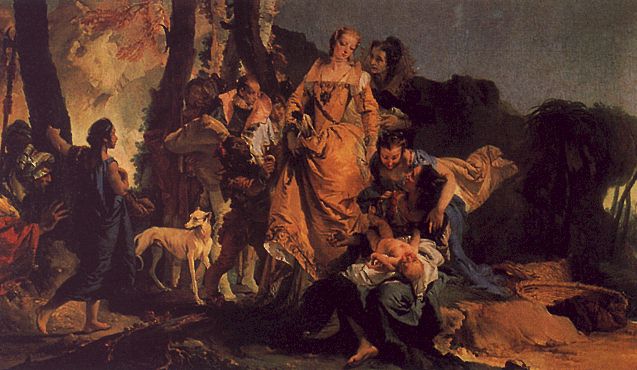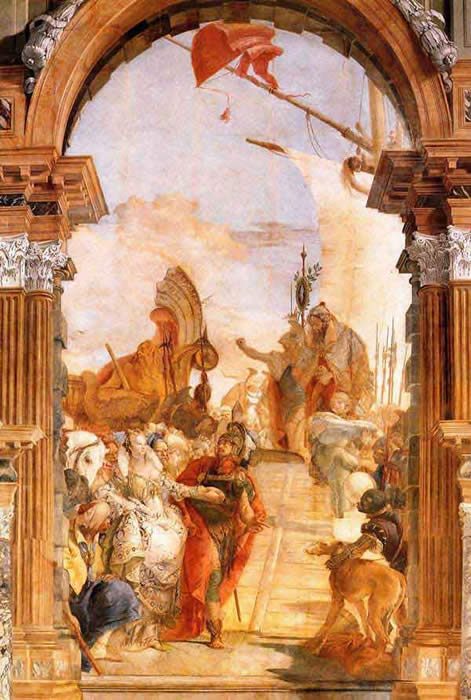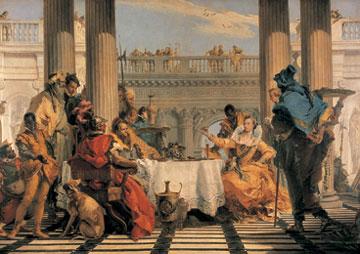Article First Appeared on BARAKA BOOK n° 5 - 1997
The Sighthound Imagery in Tiepolo's Art
Dr.ssa Stefania Nardicchi

One of the greatest painters of the XVIIIth century, Giambattista Tiepolo was undoubtly the most imitated and never equalled artist of the European baroque, the so called "rococo". He made pure poetry out of his works harmonizing the scenographic compositive scheme - which had its roots in the great XVIth century painting tradition of Veneto - thanks to the bizarre, whimsy irony of the baroque culture and to a theatrical emphasis always on the threshold of reality and fancy.
His wit - pictorial in the study of the chromatic and light effects, in the dinamism and richness of the artist's compositions and in the vertiginous spaces which appear behind fictious architectures - is always looking for surprising effects and new expressive forms which go from the pathetic to the passional and heroic.
Each time he touches passional and dramatic subjects, so deeply rooted in his baroque soul, such as for instance Antonio and Cleopatra's or Rinaldo and Armida's love, his never ending sensuality melts in light colours and gives form to women figures of such a beauty which thee tongue of men can not even refer. They are the main characters of an undoublty mannered and yet grandiose, baroque fairy tale.
Tiepolo's art wants the observer to feel something, to be upset and seduced by a whirling of lights and colours till his mind gets to the vision of a show were he is at the same time both the spectator and the protagonist. I felt all these sensations when admiring Tiepolo's works (coming also from foreign Collections and Museums) exhibited at the Ca' Rezzonico for an exhibition organized in Venice on occasion of the Third centennial anniversary of the Venetian painter's birth. I could so at last admire his masterpieces - also thanks to a very interesting sight of the town - in their natural and original frame.
Being a lover of light colours and harmony, Tiepolo often introduces in his works an element which was already characteristic of the Venetian painture i.e. the sighthound.
Whether they are Greyhounds, Salukis or Sloughis the sighthounds portrayed by the artist it is hard to say because the distinctive features of each breed are attenuated till they fade away and become part of a same subject. What I am certain about is that the introduction of the sighthound by the artist is not a mere chance, a simple emulation of Paolo Veronese's works, but it has a specific meaning being in relationship with the represented subject and becoming from time to time an element of social or historical contestualization or a means of focusing the main dramatic action. In order to thoroughly understand the functions of the sighthound in Tiepolo's art, I deem it better to linger on the analysis of some of his masterpieces where we find such an element.
Let's take for instance the two Greyhounds we find in his juvenile works "Diana e Atteone" and "Diana e Callisto", dating back to the 1720 and exhibited at the Gallerie dell'Accademia in Venice. They are an attribute of the Goddess of Hunting and faithful companions of the hunter, Atteone, who has been discovered by Diana while spying over her taking a bath and punished by transforming him into a deer which the goddess' sighthounds are going to tear to pieces.
The still and impassive Saluki sitting at wise Salomon's side in the full bloom of its primeval fierceness, represented on the fresco of the Arcivescovado of Udine comes out historically faithful quotation of the lands governed by Solomon, King of Israel and husband of the pharaoh's daughter of Egypt as well as a symbol of the great wisdom, intelligence and renown of the biblical hero. In the frescoes of the Colleoni Chapel in Bergamo, accomplished in 1733, close to the figure of John the Baptist we find a Saluki, that in the lunette representing the "Predica alle Turbe" - where we find it curled and dozing at the foot of an eastern man wearing a turban on his head - is an element of historical-territorial contextualization whereas in the lunette with the "Battesimo di Gesù" besides being the central element of the composition it represents a witty expedient for the observer's perspective who can penetrate the work with his sight. It is also the expression of Tiepolo's virtuosism as for instance, while nearing the Giordano river to drink from its waters, its image is wonderfully reflected on them.
We find again such a motive in the "Decollazione del Battista" exhibited at the Nationalmuseum of Stockholm, in the foreground close to the beheaded dead body of the Baptist in the background of the painting.
In the fresco of Bergamo we no longer find the sighthound which was in the model, but an old ugly shrew wearing a XVIth century dress, the same one that at the height of her ugliness and shrewness we find again in the big painting with "Mosé salvato dalle acque" of the National Gallery of Scotland in Edinburgh. Such a big painting (205x475), horizontally developed, was ordered by Andrea Antonio Giuseppe Corner and it very likely decorated the long wall of the big salon on the noble floor of the family's palazzo the windows of which face the Canal Grande in Venice. Unfortunately the painting was mutilated on its right side in the XIXth century where had been represented a halberdier and a sighthound with a river, may be the Giordano, in the background in the attempt of reconstructing a unity of the whole scene and landscape moving around the image of the beautiful daughter of the pharaoh. Having the possibility of observing the two fragments at the exhibition in Venice, I have been surprised by the bright innovative compositive scheme adopted by the painter, where the holy event becomes just a pretest to a lovely representation of a group of figurants (some of them wearing beautiful XVIIIth century cloths) within an enchanted fluvial landscape. Even directing the composition in the Veronese fashion, Tiepolo puts the main event on the background and creates, in the narrow path along which the characters move, something like a perspective diagonal which suggests the observer to push his sight from the habeldier and the Grey on the right into the depths meeting on his way, at the same level of the Greyhound, firstly the crying new born baby portrayed as if upside down and then deeper a second amazing greyhound ecorting a procession still and yet beware of the sudden arrival, from a path on the left, of Miriam, Mose's sister who is hurrying up to ask the princess to appoint her mother as the baby's nanny. In this painting the two Greyhounds can be regarded as characterizing a social status and are integral part of the compositive pattern as they drive the observer's sight along the main "action lines" of the whole work, till he reaches the main event placed on the background. Moreover the Greyhound and the habeldier on the far right side, being cut from the frame, create a spacial illusion, something like a contiguity between the fictious reality of the painture and the day to day reality of the observer.
One of Tiepolo's most favourite subjects is Antony and Cleopatra's love story placed in rich buildings or landscapes full of sensuality and atmosphere. In the compositions like the "Banchetto di Cleopatra" of Melbourne and its model kept in Paris (Museé Cognacq-Jay) dating back to 1744, there is always a sighthound held on a leash by an Egyptian servant. In the Melbourne painting such a servant is represented sitting at the Roman commander's foot and looks at Cleopatra - like the other characters of the scene - at the moment when she is letting one of her precious pearls fall down in a glass of vinegar, so winning the bet over Antonio.
Another wonderful Greyhound on the leash of a faithful servant welcomes Antonio in Egypt in the grandious fresco of the Ca' Lavia in Venice, accomplished towards 1750 following the model kept at the National Gallery of Scotland of Edinburgh. The event has been transformed in a sumptuous dress parade having its core in the voluptuous embrace of the two lovers who under the vigile sight of the Greyhound - their pendant- are getting down the steps as if "entering" the salon of the Venetian palazzo. A gorgeous Sloughi welcomes the Emperour Henry III at the Contarinis' villa on the Brenta river in a fresco that, detached from its original collocation (i.e. the above said Villa), has been brought to Paris and exhibited at the Museum Jacquemart-André. Here the mere presence of a sighthound ennobles the whole compositions and the harmony of its athletic body suggests feelings of harmony and elegance.
Whoever gets up the step of the Würzburg Residence will be charmed by the gorgeous Saluki on the foreground on the fresco painted by Tiepolo in 1751, ordered by the Prince Bishop Carl Philip von Greiffenclau. A very powerful body and yet a very gentle attire, distinguish such a Saluki making of him the symbol of the social prestige of the committent. All the sighthounds portrayed by Tiepolo share some common characteristics as for instance their priviledged position in the compositions and elegant postures. Moreover they play a very important dramatic role drawing the observer's sight on the main subject of the composition which is in the background and of which they can be regarded as witnesses of his/her valour.
As his friend and contemporary Algarotti says of him, Tiepolo is an artist of "pictoresque erudition" who like the classicist Poussin gives a particular meaning to each element introduced in his work connected to the represented subject.

